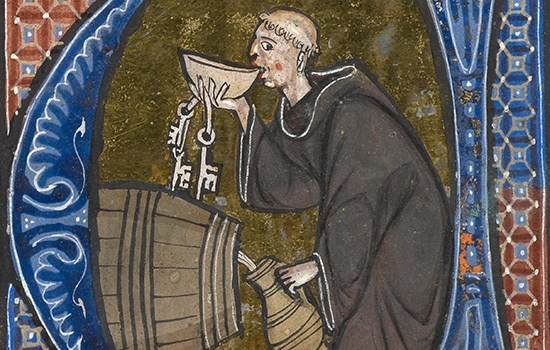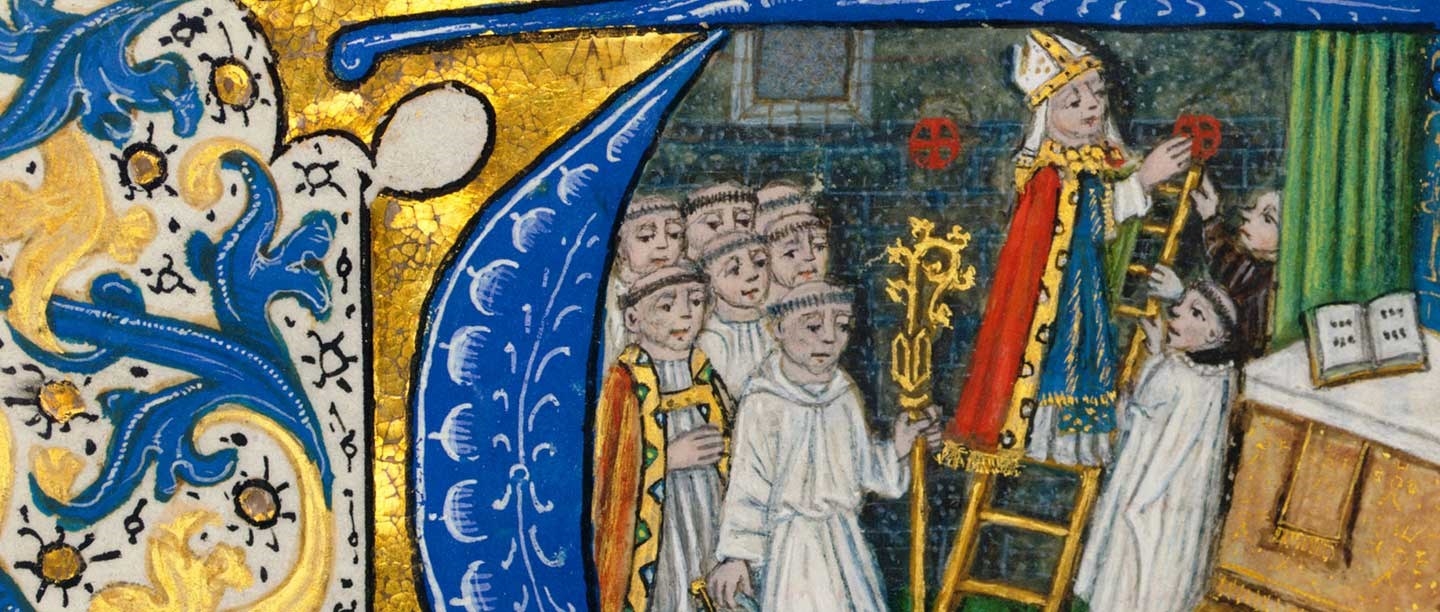The arrival of the Relic
Relics played an important role in medieval belief and worship. They provided physical, tangible reminders of the saints and assisted people in their devotions. Relics were also believed to offer physical protection and many had miracles attributed to them. The most prized relics of all were those associated with Christ’s suffering during the Passion, including the blood He shed on the Cross.
While in Germany in 1268, Edmund, son of Earl Richard of Cornwall, the founder of Hailes, obtained what was believed to be a portion of the blood shed by Christ on the Cross – the Holy Blood. The relic was thought to have come from the coronation regalia of Charlemagne, the first Holy Roman Emperor. To the medieval mind, there could not have been a better provenance, and the relic was widely accepted as authentic.
Edmund presented a portion of the blood relic to Hailes (he gave another to the college he had founded at Ashridge in Hertfordshire). Great ceremonies accompanied the arrival of the relic at the abbey on 14 September 1270, the Feast of the Holy Cross.
The Holy Blood was held within a crystal container. A 16th-century seal, used to grant admission to the abbey’s confraternity (or brotherhood), gives us the best impression of what the relic would have looked like. A priest is depicted holding an orb with a cross on top, which contains the Holy Blood of Hailes. View the object in 3D for a closer look.
View the object in 3DHousing the Shrine
The Holy Blood was first housed in a temporary shrine but such an important relic required an equally impressive home. To allow for the veneration of what was believed to be a relic of the greatest sanctity, an entirely new east end to the church was constructed on a magnificent scale.
The design was almost certainly inspired by Henry III’s rebuilding of Westminster Abbey. The swelling beauty of the deep chapels eclipsed anything previously used by the Cistercians in England. The new east end at Hailes was completed in 1277 and consecrated with great ceremony.
Pilgrimage to Hailes
The relic immediately became a focus of pilgrimage. It was believed that the relic would only be visible to people whose sins had been forgiven after confession and penance. This attracted pilgrims who were worried that they remained in a state of sin after confession and after performing the penance imposed by their parish priest.
Several popes issued indulgences that granted spiritual benefits to pilgrims visiting Hailes who contributed to the upkeep of the abbey and its buildings. Chaplains were appointed to bless the rosary beads which pilgrims had touched against the shrine in the belief that some of the sanctity of the relic would be transferred to them.
A senior monk known as the altararius welcomed pilgrims to the shrine, displayed it to them at appointed times, and accepted their offerings to the monastery. The story of the arrival of the relic at Hailes was written on a tablet hanging close to the shrine.
A Famous Poem and a Famous Pilgrim
The fame of the Holy Blood of Hailes ensured that it found mention in the greatest of all English medieval poems on pilgrimage: Geoffrey Chaucer’s The Canterbury Tales. Appropriately it occurs during The Pardoner’s Tale (pardoners were licensed to issued indulgences or pardons for sins):
By God’s Precious heart and by His nails
And by the blood of Christ that’s now at Hailes.
Margery Kempe, the important 15th-century mystic, was among the pilgrims to Hailes. She visited Hailes in 1417 while travelling back to Norfolk from the great shrine of St James the Great at Compostela in northern Spain. At Hailes she confessed and received forgiveness for her sins ‘with loud cries and tears and boisterous weeping’. Her devotion impressed the monks, who invited her among them for further discussion. Quoting from the gospel, Margery rebuked the monks for swearing, causing them ‘great wonder’ and leaving some ‘right well pleased’.
Miracles of the Holy Blood
According to the Tudor antiquary John Leland (c.1503–1552), ‘god daylie sheathe miracles throwe the virtue’ (‘God daily shows miracles through the virtue') of the Holy Blood of Hailes. The relic was purported to cure the sick and even raise the dead.
Four miracles are described in detail in an early 16th-century pamphlet. Two of the tales concern Lollard priests who, under the influence of John Wyclif (c.1330–1384), denied that the Blood of Hailes was a true relic of Christ’s suffering and denounced pilgrimage to the monastery. In one, a priest in Shropshire attempted on Easter Sunday to dissuade his parishioners from making the pilgrimage to Hailes. When he next said Mass, the wine in the chalice boiled up, prompting the priest to see the error of his ways and compelling him to join his parishioners at Worcester to complete the journey to Hailes.
In the second tale, a priest near Derby denied the authenticity of the Blood and attempted to impede the entry of pilgrims to the abbey. In punishment for this sacrilege, his service book started to bleed. He quickly confessed his error and made his own pilgrimage to Hailes.
Other stories concern lay people and demonstrate the practical assistance the relic was thought to provide, and how it could even avert disaster. In one of the tales, a baker and his wife had set up a stall at the abbey during the pilgrimage season. On departing, they loaded their cart with their goods and their three children. The couple then returned to the abbey to venerate the relic. In their absence, the horses bolted into nearby quarries. Although the cart was smashed to pieces, the children were unharmed. In another story, the relic is supposed to have freed two men from captivity in France. They subsequently made the pilgrimage to Hailes, where they told the monks of their miraculous release.
Destruction of the Shrine
When Henry VIII started to reform what he saw as the abuses within the Catholic Church – particularly the financial gains made from holy relics – Hailes Abbey was soon in the sights of the evangelical reformers. In 1533 Hugh Latimer, an early convert to the evangelical cause and then rector of West Kington, complained of the flocks of pilgrims passing his house, ‘to many shrines, but chiefly to the blood of Hailes’. Pilgrims continued to make offerings to the relic – in 1535 they amounted to £10, a substantial sum for the time.
In that year the king and queen travelled through western England, visiting Winchcombe Abbey, a few miles from Hailes. According to one source, Anne Boleyn sent some of her chaplains to enquire into the ‘abomynable abuse’ of pilgrimage to Hailes. Three years later, the relic was denounced during a sermon outside St Paul’s Cathedral in London as being nothing more than duck’s blood. Commissioners, including Latimer, who by then was Bishop of Worcester, were dispatched to Hailes to examine the relic. After pronouncing it to be not blood but an unctuous gum, they sealed it in a box and took it with them to London. In November 1538, Bishop John Hilsey of Rochester, a fierce evangelical, delivered a fiery sermon at St Paul’s Cross in which he declared that the blood was nothing more than clarified honey coloured with saffron.
The shrine of the Holy Blood was stripped of its precious metal and jewelled adornment and then dismantled. Soon after, Hailes fell victim to Henry VIII’s Suppression of the Monasteries. On Christmas Eve 1539 Abbot Sagar and the community of 21 monks signed the surrender deed. The church, which for almost 200 years was home to one of the greatest relics of medieval England, was rapidly reduced to ruins.
Read More
-

A mini guide to Medieval Monks
Do you know the difference between the Benedictines, Cluniacs, Carthusians and Cistercians? This short animation will guide you through the different religious communities in medieval Britain.
-

History of Hailes Abbey
Discover the full story of Hailes Abbey, from its foundation in the 13th century to its downfall under Henry VIII and subsequent rediscovery in the 19th century.
-

Misbehaving Monks of Hailes Abbey
From visiting taverns to singing at the wrong pitch, the monks of Hailes Abbey couldn’t always meet the high standards expected of them.

